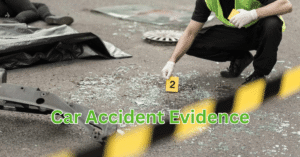What Evidence Do You Need for a Car Accident Claim in Utah?
A strong car accident claim relies on clear evidence. Take pictures and videos, obtain a police report, medical records and bills, witness names and statements, and obtain repair estimates. Save phone records, pay stubs, and daily pain notes to connect losses.
People often feel confused and worried after a crash. If you are injured or your car is damaged, insurance adjusters want answers. It is evidence that makes a claim credible and takes your story seriously. In Utah, the right proof shows what happened, who caused it, and how the crash changed your life.
We have written this guide that explains what to collect, how to collect it, and how each item helps.
Key Points You Should Know
- Photos and videos help tell the truth.
- Police reports and 911 calls add key facts.
- Medical records link injuries to the crash.
- Witness statements support how events unfolded.
- Vehicle data and cameras confirm speed and impact.
- Keep bills, pay stubs, and repair estimates.
- Utah PIP pays early medical costs.
- Comparative fault rules affect your payout.
- Request your Utah crash report online.
The Evidence That Builds a Strong Utah Claim
There is no point in making a claim unless it is supported by evidence. Let’s start with what is unarguable: photos, video, police reports, medical records, and witness statements. Attach documents showing money losses, such as repair bills, rental costs, and missed wages. If cameras were nearby, ask for copies before they are deleted. Many stores, homes, and cities record video on short loops, sometimes for only days.
The police report matters because it records time, place, weather, road layout, and names of drivers and witnesses. It may include a diagram and a first take on fault. Accident reports are created by Utah officers as part of the official record. You can request it later through the Utah Department of Public Safety portal.
Your medical proof is the bridge between the crash and your pain. Go to urgent care, an ER, or your doctor right away, even if you feel “okay.” Many injuries worsen later. Keep every record, bill, prescription, and referral. These documents help a Utah car accident lawyer show insurers how the crash harmed you.
How To Collect Evidence After a Car Crash?
Step 1: Safety first
Make your way to a safe place. Whenever there is a danger, an injury, or a traffic hazard, quickly call 911. Get medical care quickly. Early care helps your health and creates a time-stamped record.
Step 2: Call the police and get the report number
Ask the officer how to get the report and note the case number. In Utah, investigating officers complete an accident report. You can request the report online through the state portal when it is ready.
Step 3: Photograph the scene
Take wide and close-up shots. Capture skid marks, debris, traffic signals, lane signs, and vehicle positions. Photograph VIN stickers, plates, and insurance cards if shown.
Step 4: Gather witness info
You should ask for names, phone numbers, and emails. Ask them to text you what they saw while it is fresh. Do not edit their words.
Step 5: Protect digital proof
Save dashcam clips. Ask nearby homes or shops to save their camera files. Many systems auto-delete within days.
Step 6: Track care and costs
Save bills, visit summaries, and work notes. A Utah car accident lawyer uses these to show the claim value.
Photographs That Help Your Car Accident Claim
Three questions can be answered by good photos: what was hit, how it was hit, and how hard it felt. When possible, shoot during clear daylight; however, if light is fading, do not wait. Use your phone’s grid to keep lines level.
Take these sets:
- Wide shots of the whole scene from four sides
- Medium shots of each vehicle corner and side
- Close-ups of dents, paint transfer, broken glass, and air bags
- Weather conditions and road surface, including ice, rain, and gravel
- Photos of visible injuries the same day and as they heal
Turn on location and time stamps if your phone allows it. Keep the original files. Do not add filters or edits. If a loved one takes photos for you, have them send the originals. These images give Utah car accident attorneys clear, time-stamped proof of what happened.
Witness Statements: What To Ask and a Simple Example
Witnesses help fill gaps. Observe, hear, and do what they see and hear. Use their own words and keep it short. Key points include where they stood, what they noticed first, and any sounds like brakes or horns.
What to ask:
- Where were you standing or driving?
- What did you see just before impact?
- What did you notice about speed or signals?
- Did the other driver say anything after the crash?
Keep the original text or audio. Share it with your lawyer unchanged.
Police Report, 911 Audio, and Camera Footage
The police report is a backbone document. It lists drivers, insurance, road layout, and early findings. In Utah, officers complete an accident report as part of their duties. Obtaining a copy is possible through the Utah Department of Public Safety’s Public Records Portal. Have your case number ready when you search.
Ask for 911 audio if calls were made. These recordings can capture pain levels, confusion, and how quickly help arrived. Some cities keep these files for a short time, so act fast.
Do not forget public and private cameras. City traffic cameras, store security, and home doorbells can show signal status, speed, and impact. Many systems overwrite files within days. A letter asking the owner to keep the footage can help. A Utah car accident lawyer can send formal preservation letters when needed.
Medical Records and Bills: Proof That Links Injury to the Crash
Medical proof connects the crash to your pain. Go on day one if you can. Tell the provider exactly what hurt before the crash and what hurts now. Ask for visit summaries and keep every bill. Save receipts for braces, prescriptions, and devices. If you miss work, ask for a work note and save pay stubs that show lost income.
Utah is a no-fault state for early medical bills. Your personal injury protection coverage, often called PIP, pays at least the first $3,000 in medical costs, subject to your policy terms.
Keep a simple daily journal. Note pain levels, sleep issues, and how the injury limits house chores or work. This helps Utah car accident attorneys explain how the crash changed daily life.
Vehicle Data, Dashcams, and Digital Proof
Modern cars store crash data in an event data recorder. This can show speed, braking, seat belt use, and throttle just before impact. A skilled team can download it if the car is preserved. Do not rush to repair or sell a totaled car before your lawyer reviews it. Dashcam clips, rideshare trip logs, and phone photos from passengers can also help.
Ask nearby stores or homeowners for copies of their video. Be polite and quick. Time matters. If you cannot visit, write a short letter or email asking them to save the file. Your lawyer can follow up with a formal request.
Phone records can show call times if distraction is an issue. Map apps can show travel routes. Put all digital items in a labeled folder with dates. A Utah car accident lawyer will know which parts to use and how to explain them to an adjuster or a jury.
Contact the Best Utah Car Accident Attorney
After a crash, you face calls, forms, and the stress of healing. A strong lawyer steps in and takes over the heavy lift. They gather records, talk to witnesses, order the police report, and line up experts. They know which facts move an adjuster and which photos a jury understands.
Personal Injury Lawyers Team – Treating Your Case With the Utmost Care
When you are ready, consult with the best car accident lawyer, Chris Cockayne and his team at Cockayne Law. They handle car crash cases across Utah and understand what proof settles claims. The team can secure dashcam and street-camera video, send preservation letters, and work with accident-reconstruction experts when needed.
They order your crash report through the state portal, track your medical records and bills, and present a clear story of how the crash affected your life. They also know Utah rules on PIP and comparative fault and how those rules affect outcomes. If an insurer disputes fault, they build with facts, not guesswork.
Contact an experienced Utah car accident lawyer early and let them protect the evidence that matters.
Final Thoughts
Evidence is time-sensitive. Photos fade, cars get repaired, and camera files are erased. Start a simple checklist the day of the crash. All your documents should be saved in one place, and you should keep a short daily journal.
Ask for the police report, keep your care on schedule, and follow provider advice. When you are ready, speak with a trusted Utah car accident lawyer to review the proof and fill any gaps. If you prefer a focused local team, Cockayne Law can step in and help you build the record you need. Solid proof makes fair results more likely.
FAQs
What is the most useful evidence after a Utah crash?
Photographs of the scene, police reports, medical records, and contact information for witnesses. Add dashcam clips, traffic or store video, and repair estimates. Together, these items tell a full story the insurer cannot ignore.
Can I use dashcam and street-camera video?
Yes. Dashcams and nearby cameras can show lane position, speed, and signal status. Ask owners to save files quickly. Many systems are overwritten within days. Lawyers can send formal preservation letters if needed.
How long do I have to file a Utah injury case?
Most car crash injury cases must be filed within four years, though special rules can shorten or change the time. Do not wait to gather proof. Ask a lawyer about your exact deadline.
What should a witness statement include?
Name and contact info, where they were, what they saw before and at impact, details like speed, lights, sounds, and what drivers said. Keep it in their own words and save the original text or audio.
Should I post about my crash on social media?
It is safer to avoid posts. Insurers check public pages. A smiling photo or gym check-in can be used against your claim. Keep updates private and share details only with your care team and your lawyer.









